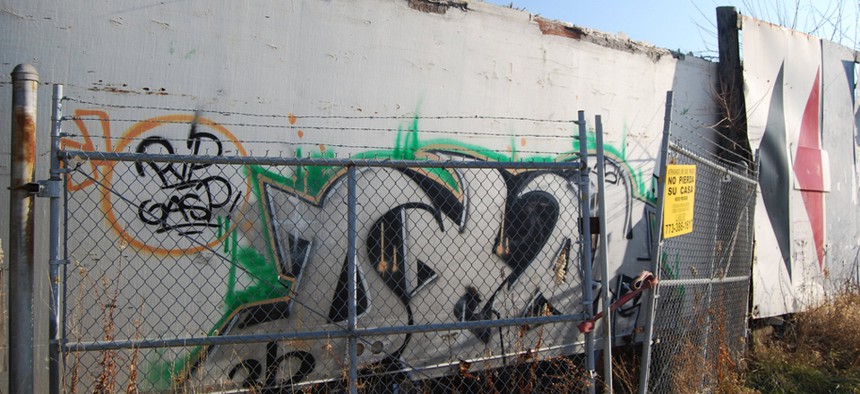In Europe and America, Segregation Continues

Graffiti dots parts of Chicago's south side. Flickr user Michael Kappel
A new report outlines drivers and patterns of residential segregation—and why they are so hard to break.
Chatham , a historically working-class, majority African-American neighborhood on Chicago's South Side, has had its share of post-recession struggles . Joyce Sallie has lived there for a year and a half, and says the area has declined in several ways. In the time she's lived there, she has witnessed three shootings.
"People be shocked that I still live where I live because it's so bad ... gang-infested, germ-infested, dirty," says the 25-year-old Boston Market employee. "I wouldn't wish my neighborhood on my worst enemy."
Chicago is one U.S. city where residential segregation is especially visible, something that a new report released by the Migration Policy Institute backs up. The report examines patterns and drivers of segregation in cities in Europe and America along racial, ethnic and socio-economic lines.
There's nothing inherently bad about segregation, says John Iceland, sociology professor at Penn State and author of the report. It's natural that people want their neighbors to share their experiences and culture . But in practice, residential segregation is an indicator of social distance between groups. It reproduces and reinforces social inequalities—school quality, joblessness, poverty, and crime—which persist over generations.
"It’s kind of the legacy of these 'black ghettos' in these rust belt cities … they don’t go away," he says.

This map, based on 2010 Census block data shows the racial segregation in Chicago's South Side.
The report shows that the structure of cities has a large influence on residential segregation. American cities tend to be sprawled out, which isolates spaces where low-income groups and minorities live, says Iceland. European cities, on the other hand, are denser and more compact; fewer physical divisions means that these cities are less segregated in general, the report says.
In America, African-Americans are still most residentially segregated as a direct result of Jim Crow segregation laws and discriminatory housing policies that gave blacks little choice as far as neighborhood mobility . Vestigial discrimination from these policies remains, even in Hispanic and Asian populations, which tend to live in more "integrated" neighborhoods.
In Europe, on the other hand, it's immigrant populations—specifically Muslim ones—that live in insular neighborhoods. In Britain, Pakistanis and Bangladeshis clot together; in the Hague, it's Turkish and Moroccan communities; and in France, North-African and Caribbean groups.
When immigrants arrive in a new city, they move into what Iceland calls "ethnic enclaves" because they seek familiar faces and culturally similar support networks. The report says that subsequent generations of immigrants actually tend to move away from these enclaves, signaling a higher degree of assimilation. Despite this, these generations still show restricted upward mobility.
While the roots of segregation may be different, the effects are similar across the board, the report says. So if segregation is both the disease and the symptom, what's the cure?
In European cities, policymakers have had a neighborhood-focused approach to chipping away at residential segregation, trying to improve conditions in situ . In France, for instance, the government has tried urban renewal programs and given tax breaks to businesses to lure them to the neighborhoods, says Patrick Simon, research director at National Demographic Institute at Sciences Po inParis. Other cities, including Berlin, Rotterdam, and Frankfurt, have experimented with housing-allocation programs aimed at diluting the concentrations of ethnic populations in certain neighborhoods. In America, housing vouchers and scattered-site public housing initiatives enable low-income families to move to neighborhoods with better resources. All of these have helped to some extent, but the overall the effects are small, says Iceland. A mixed approach tackling the economic inequalities and a broader look at immigrant integration are strategies to consider, he says.
A new initiative called Cities for Citizenship aims to do the latter. The campaign,launched by the mayors of New York, Chicago, and Los Angeles and in partnership with nonprofit organizations, offers eligible immigrants help with the naturalization process. Despite working lawfully, 52 percent of permanent residents are low-income, and making the switch to U.S. citizenship is one of the most important things immigrants can do to advance economically, says Joshua Hoyt , director of National Partnership for New Americans , one of the partnering nonprofits.
Iceland thinks this might help.
"Helping people feel a part of their host society—be it in the U.S., or in France, or any other place—is critical,” says Iceland.
But a comprehensive solution to this historical, complex, and multi-layered problem remains elusive, and stereotypes keep the physical divisions intact. A white resident of downtown Chicago, for example, might not consider the South Side a safe or viable place to live, even though not all neighborhoods are in the same condition as Chatham. A black South Side resident, may just as well not want to live in an all-white area because of the threat of discrimination, says Iceland.
If Sallie had the resources, she would personally love to live in downtown Chicago. But for the moment, anywhere else is better than Chatham.
"I don't know what other people do," she says. "Me—I got to go."
( Top image via Flickr user Michael Kappel )
NEXT STORY: Local Government’s Big Text-Message Quandary





